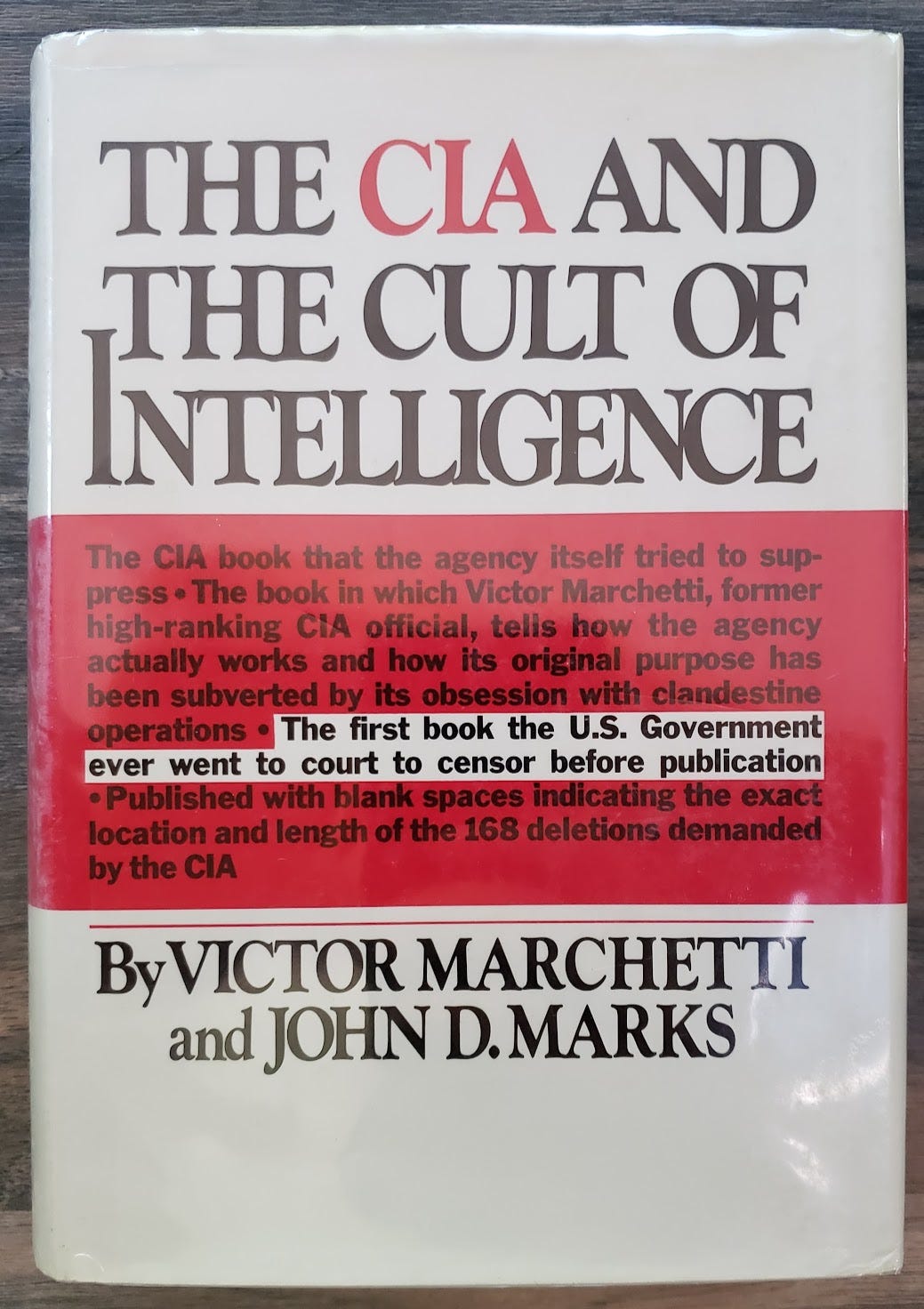The CIA and the Cult of Intelligence is a book co-authored by both Victor Marchetti and John D. Marks. Marchetti provides insider information on the CIA, having served from 1955 to 1972, rising to the rank of executive assistant to the Deputy Director. Marks joined the State Department in 1966, where he worked as an analyst and then staff assistant to the Intelligence Director until 1970. The book proudly displays its unique history on the cover:
The authors fought in court against the CIA, and were able to “de-censor” some of the passages that the CIA wanted removed from the book. The remaining censored text is, as the front cover says, represented by blocks of whitespace that denote the exact length of what was removed. The amount that the CIA attempted to censor and was able to censor is certainly not trivial.
The first part of the book I find worth commenting on is not until the third chapter “The CIA and the Intelligence Community.” This chapter addresses the CIA’s role in the larger intelligence agency network, and gets into specifics about its personnel count and budget, both of which the CIA attempted to censor out of the book.
The chapter opens with the figures of an official employee count of 16,500 and an annual budget of $750,000,000, but these figures are both misleading. The personnel count does not account for tens of thousands of contractors or CIA proprietary companies. Sloppy record keeping, intentional and otherwise, and compartmentalization make an accurate count impossible. Additionally, contracted agents tend to be retained with monthly payments permanently.
As far as the budget goes, the CIA’s for-profit corporations such as the Pacific Company, which held Air America and Air Asia, were larger than the official count of the CIA itself and provided revenues in the tens of millions per year in addition to services. In some cases, the companies become too large and independent to be effectively controlled or dissolved.
The CIA budget is also largely inflated through the Pentagon’s budget. The CIA is routinely contracted to develop science and technology for the military, particularly the Air Force, which at the time spent at least $400,000,000 funding the CIA’s Science and Technology Directorate. The CIA was thus a multi-billion dollar enterprise back then and these figures are obviously much larger now.
Another interesting part of the CIA’s budget is the Contingency Fund, which was a $100,000,000 fund that the CIA could call on to spend in an unregulated and confidential fashion. This money, as expected, was many times used to corrupt ends. Two examples given were when Secretary of Defense Robert McNamara promised millions of dollars worth of air defense equipment to the Norwegians in 1967; equipment that was not available in inventory. It was therefore purchased through White House approval via the CIA’s emergency funds.
Perhaps the more egregious example was when the Contingency Fund was used to pay for the lavish spending of President Johnson at a resort in Uruguay during a diplomatic conference. (p 64.)
Much of the rest of the chapter details the CIA’s place in the “Intelligence Community.” The CIA accounts for only 15% of the funds and personnel in this community. The authors describe the community as “fiercely independent bureaucratic entities with little desire for outside supervision.”
As we know from the previous book on the CIA, the CIA was founded with the mission of “coordinating the intelligence activities of the several government departments and agencies,” avoiding this problem of disparate agencies; we also know that what the CIA actually became was the covert foreign policy arm of the US government.
The authors go through some of the attempts to solve this problem, such as the creation of the DIA (Defense Intelligence Agency), which was intended to resolve the self-serving aspects of military intelligence. On this, the authors write:
“The tribalism that plagues the intelligence community is at its worst in the military intelligence agencies, and most of the personnel working for these organizations feel their first loyalty is to their parent service. The men who run military intelligence are almost all career officers who look to the Army, Navy, and Air Force for promotion and other advancement. They serve only a tour or two in intelligence before they return to conventional military life. Very few are willing to do anything in their intelligence assignments which will damage their careers, and they know all too well that analysis on their part which contradicts the views of the policies of the leadership of their parent service will not be well received. Thus, their intelligence judgements tend to be clouded by the prejudices and budgetary needs of the military service whose uniform they wear.”
The authors cover in some detail the overall organization of the intelligence community and the CIA, including some mildly interesting bits about how the CIA self-manages its retirement investment funds and about its Historical Staff, which contracts retiring agents to write memoirs in-house under supervision; I won’t belabor this logistical details here.
That concludes Part I of the book.



